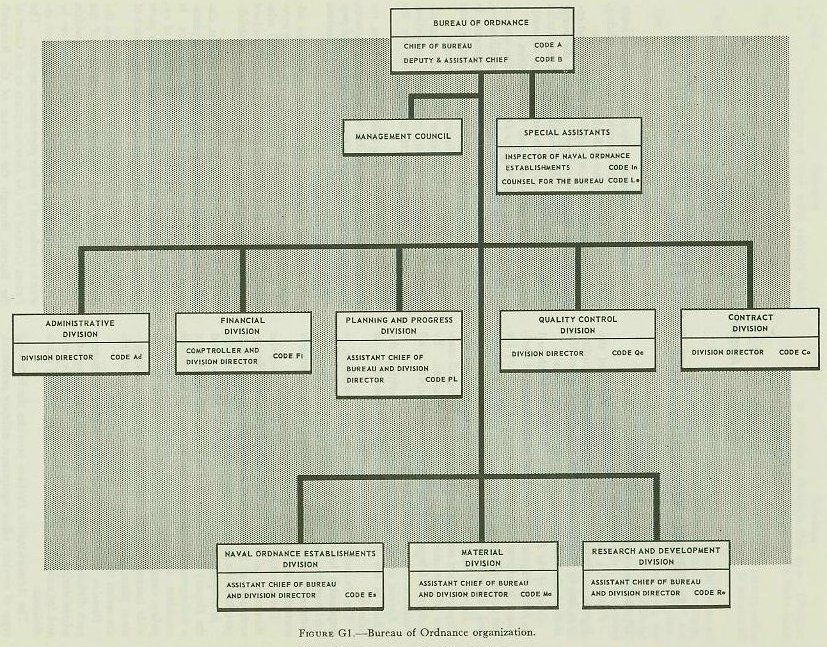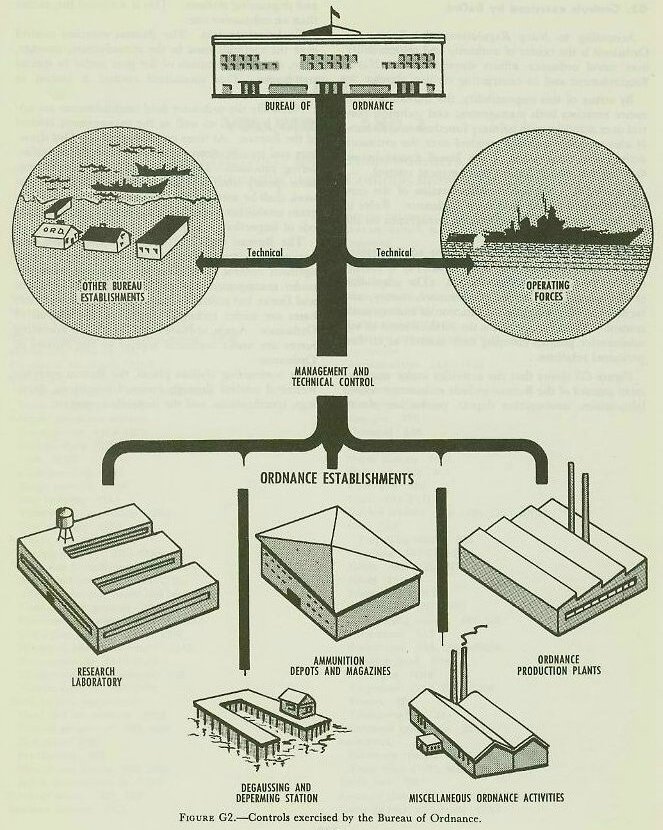| GENE SLOVER'S US NAVY FIRE CONTROL PAGES NAVAL ORDNANCE AND GUNNERY VOLUME 2 FIRE CONTROL Appendix G BURREAU OF ORDNANCE FUNCTIONS AND CONTROLS |
| BUREAU OF ORDNANCE FUNCTIONS AND CONTROLS G1. Bureau organization Figure G1 shows the general organization of the Bureau of Ordnance. The paragraphs below outline very briefly the functions and responsibilities of the individuals and groups mentioned on the chart. |
| Chief of the Bureau. Within the limits established by Navy Regulations, the Chief of the Bureau of Ordnance is responsible to the Secretary of the Navy for the active planning, direction, coordination, and control of the Bureau as a whole and its field activities. Deputy Chief. As principal adviser to the Chief, the Deputy Chief must be well informed regarding all matters of operation and policy within the Bureau. By authority delegated by the Chief, he may supervise all Bureau activities and act for the Chief. Special assistants. At the time of this writing, the Chief of the Bureau has two special assistants, as follows: The inspector General, Bureau of Ordnance, is responsible for investigating efficiency, safety, industrial hygiene, and adherence to directives at all naval ordnance stations. Where necessary, he recommends corrective action. The Counsel for the Bureau advises and serves the Bureau in all legal matters except patents. He coordinates all legal matters (other than patents) that pertain to the Bureauís mission and its accomplishment. Management council. The division directors and the Deputy Chief-who acts as chairman-constitute a management council for the Bureau. The council considers and recommends beneficial changes in policy, control systems, and other matters of Bureau-wide interest. It discusses and coordinates management plans, policies, and objectives, bringing to this discussion the several divisional viewpoints. Division directors. Subject to higher authority, each division director is responsible for organizing and administering the specialized activities of his division, and for coordinating its activities with those of other divisions. The Administrative Division provides the following types of service: office equipment, military personnel, civilian personnel, management, and technical library. Its budgets for administrative expenses, administers security regulations, and provides for the editing, printing, and distribution of Bureau publications. The Financial Division prepares, allocates, and coordinates the Bureauís budget. It reviews the budgetary requirements of the several divisions, maintains the Bureauís financial records, and develops accounting systems for use at ordnance field activities. The Planning and Progress Division plans and coordinates matters involving logistics and mobilization, reports progress as compared with requirements in logistic matters, prepares the budget for logistics, and administers military aid to foreign governments. The Quality Control Division promulgates and administers appropriate quality evaluation, inspection, and testing of all products manufactured for the Bureau. As the central contracting office for the Bureau, the Contract Division is responsible for arranging finances, awarding contracts, supervising terminations, and paying contractors as necessary in carrying out the business of the several divisions. The Naval Ordnance Establishments Division administers and coordinates all matters-including service requirements, facilities, personnel, industrial relations, management, and operation-that are involved in maintaining the various naval ordnance establishments. The Material Division directs the procurement, distribution, maintenance, repair, alteration, replacement, and inventory control of all naval ordnance. It provides for the safe handling and surveillance of explosive ordnance. It also prepares manuals-or parts thereof-devoted to the operation and maintenance of naval ordnance. The Research Division directs and implements the research, design, and development activities of the Bureau, whether these activities are carried out within the Ordnance Establishment, at universities, or by private contractors. It also coordinates pertinent research conducted by other government agencies. The Patent Counsel for the Bureau reports to the Chief of the Bureau through the director of the Research Division. G2. Controls exercised by BuOrd According to Navy Regulations, the Bureau of Ordnance is the center of authority and responsibility over naval ordnance affairs throughout the Naval Establishment and its contracting civilian plants. By virtue of this responsibility, the Bureau of Ordnance exercises both management and technical control over activities with primary functions in ordnance. It also exercises technical control over the ordnance activities in those parts of the Naval Establishment that are not under BuOrd management control. Figure G2 is a graphic representation of the controls exercised by the Bureau of Ordnance. Refer to this figure as you read the ensuing paragraphs on the two types of control. |
 |
 |
| Management control. The routine administration of non-military matters at a naval activity is usually referred to as management control. The scheduling of the workload in terms of personnel, money, and facilities is-for example-a function of management control. Another function is the establishment of administrative policies covering such matters as civilian personnel relations. Figure G2 shows that the activities under management control of the Bureau include ordnance research laboratories, ammunition depots, production plants, and degaussing stations. This is a typical list, rather than an exhaustive one. Technical control. The Bureau exercises control over the methods used in the manufacture, stowage, issue, and transportation of the gear under its special cognizance. This specialized control is known as technical control. Naturally the ordnance field establishments are under the technical as well as the management control of the Bureau. At these establishments, BuOrd drawings and specifications set the standards for manufacturing processes. Directives and other communications specify what jobs are to be done and how the work shall be accomplished. The quality control program establishes manufacturing tolerances and methods of inspection. The Bureau exercises technical control over ordnance work at activities that are not under its management control. For example, advanced bases are under management control of the Bureau of Yards and Docks, but ordnance magazines and shops at these bases are under technical control of the Bureau of Ordnance. Again, ordnance activities in the operating forces are under technical control of the Bureau of Ordnance. At contracting civilian plants, the Bureau exercises technical control through contract provisions, drawings, specifications, and the inspection program. |